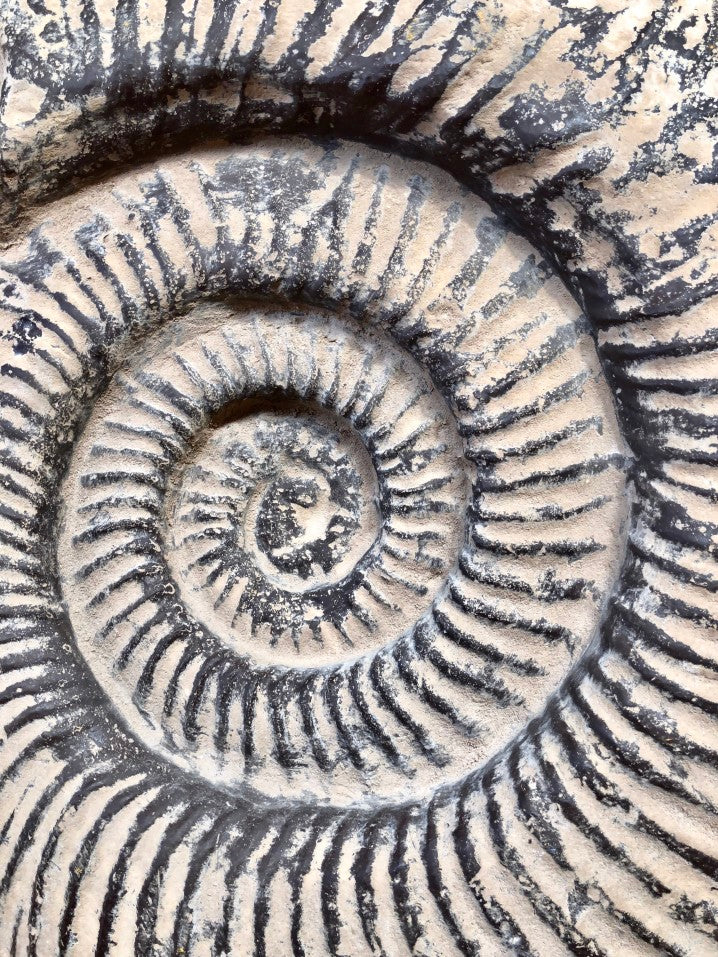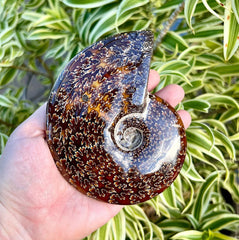
The Ultimate Guide to Ammonite Fossils
There are so many parts of the prehistoric world that are left unknown or forgotten, but with the presence of fossils, we can learn more about ancient organisms and understand more about them. Fossils are a marvelous way to admire a piece of history while also learning about the creatures that dwelled before us. In the ammonites, these organisms existed even before the dinosaurs, which makes these ancient fossils so intriguing.
The shell these ammonites leave behind are showstopping in shape, size, and color. The unique characteristics of each ammonite fossil make this piece of the prehistoric world even more admirable.
You don’t have to be a fossil enthusiast to appreciate these fossilized creatures' beauty and wonder which existed millions of years ago. Whether on display in your home or worn as jewelry, these ammonite fossils are a beautiful sight to observe. Aside from the ammonite shell's beauty, we can enjoy the preserved fossils for their ancient beauty and uniqueness. Let’s learn all about the ancient cephalopod that is the ammonite.
What Are Ammonites?
Ammonites are a prehistoric marine mollusk that roamed millions of years ago. These organisms are a soft-bodied invertebrate that protects themselves from predators with their thick shells. These water mollusks protect their invertebrate with a shell and mantle. Ammonites are classified as cephalopods and have tentacles that are attached to their head. Some common modern-day cephalopods include squid, octopus, and cuttlefish. These physical features of ammonites will help you to spot a fossil in the present day:
- Shell - Coiled or straight
- Septa - Lines that separate the body chambers
- Patterns - Intricate patterns point to specific ammonite species
- Size - From less than an inch to more than nine feet in diameter
Ammonites developed their outer shell as a defense mechanism to protect themselves while hunting fish in the shallow waters they roamed. These carnivorous mollusks eventually began to hunt other cephalopods as well. An outer shell allowed these organisms to use water propulsion to move about in the water. The physical makeup of ammonites allowed these small organisms to function well and survive through several prehistoric eras.
Geological Timestamp of Ammonites
Ammonites made their appearance on earth over 400 million years ago but disappeared before the mass extinction over 66 million years ago, with the first ammonites appearing in the Paleozoic Era. A more enhanced structure formed of the ammonite exists through the Triassic and Cretaceous periods as well. These species had a shorter lifespan, but these organisms were able to thrive for millions of years because of their ability to frequently adapt and evolve.
Experts estimated that over 10,000 different species of ammonites existed before their extinction. Some scientists believe that these prehistoric organisms could survive for so long due to plankton's presence and availability through certain seas in which the ammonite roamed.
Regardless of the extinction of ammonites, these mollusks left a trail of their history all over the earth in fossil form. Ammonite fossils are one of the most common types of fossils found, but each fossil is unique in its way. To learn more about the ammonite evolution, check out a timeline that captures the organisms evolving life from over 400 million years ago.
Ammonite Shapes and Patterns
The type of shell we most recognize as belonging to ammonites is a planispiral shell. As the ammonites mature, their shell becomes more straight and then undergoes a curvature. There are many different shapes present in ammonite shells from straight, coiled, and even partially coiled. Ammonite shells' shapes can vary so much that one species is similar in shape to a snail, and another species' shell can be straight like a hairpin. Some ammonite’s shells curved wildly without a pattern.
These different ammonite shell shapes provide insight into the different and many evolutions the ammonite underwent. These shells and unique patterns of ammonites make them easily admirable. The coiled shell is most commonly what we find preserved as fossils. Whether you are a fossil enthusiast or interest in prehistoric organisms, all can appreciate these ammonite shells. At Whaler’s Locker, our ammonite fossils boast a variety of shapes, colors, and designs. Check out our ammonite fossil collection and browse the uniqueness of this prehistoric water mollusk.
Where to Find Ammonite Fossils
When an ammonite dies, the shell drops down to the floor of rivers, lakes, and oceans. The sediment on the water floors allows for careful preservation of the ammonite shell after fossilization occurs. Because these organisms were widespread and roamed in shallow waters, many fossils were washed up in various areas and are common to find in North America and Europe. North America’s Great Plains are home to tons of ammonite fossils waiting for discovery and collection.
You can find ammonite fossils most commonly in sedimentary basins, river shores, and sea costs. Sometimes these fossils will appear at quarries, deserts, and canyons as well. The Ammonite Canyon in Nevada is famous for being a fossils production region. This Canyon is appropriately named for the many ammonite deposits found there. You don't have to get dirty to find yourself an ammonite fossil. At Whaler’s Locker, we have done the hard work for you! With the convenience of browsing our online shop, you can shop all of our fossils, including ammonite fossils, from the comfort of your own home.
Understanding Cephalopod Classes

The cephalopod class contains two subclasses: Coleoidea and Nautiloidea. Coleidea includes squid and cuttlefish, which categorize one of the most intelligent invertebrates in the ocean. Nautiloidea includes Nautilus and Allonautilus, which are more simple structured water mollusks. The ammonite evolution included developing a hard shell, but other cephalopods lost these shells over time to find new ways to adapt to a changing world. Cephalopods evolved to be very intelligent organisms, became excellent hiders, and developed strong but flexible arms.
There is much to learn about the evolutionary factors that contributed to the sophistication of these water-dwelling organisms. The modern-day cephalopods are what we think of as squid, octopus, and other similar ocean dwellers. The fantastic thing about cephalopods is that they can be as small as the tip of your finger while some species can grow up to almost 60 feet long. Humans have long been fascinated by cephalopods. With fossils' presence, we can better understand even the prehistoric organisms of the cephalopod class.
Ammonite Fossils have History of Healing
Ammonite fossils have a history of metaphysical healing properties and protective qualities. Some tribes in North America believe in the healing properties of ammonite for injuries and protection from evil spirits. These tribes also maintain that the ammonite relics bring good fortune to their lives regarding marriage, hunting, and war.
In ancient Greece, ammonite fossils were considered a holy stone for bringing to life a prophetic vision. Ammonite fossils are believed to promote clarity, and possessing one will help guide your life's path by providing insight into the bigger picture of one's importance. These are just a few of the believed properties and powers of ammonite fossils:

- Reduce pain during childbirth
- Filters negative energy for positive energy
- Symbols of powerful change
- Increase endurance
- Resolve digestion issues
- Aid in resolving degenerative issues
- Stimulate life force
There is no doubt a history of fair use brought on by ammonite fossils. Whether you want to have a piece of history in an ammonite fossil for its healing properties, charm, or uniqueness, there is undoubtedly a fossil for you. If you are interested in other earth pieces that provide healing properties, check out some of the most powerful healing crystals available at Whaler’s Locker.
Marine Mollusk Types
All mollusks are characterized by the rear covering on the body called the mantle, paired nerves, and an opening in the mantle cavity where organisms' genitals reside. Marine mollusks tend to roam on the bottom of lakes, oceans, rivers, and other water bodies but cephalopods are free swimmers. There are eight different species of marine mollusks, including cephalopods. Here are some common marine mollusks:
- Snails
- Cuttlefish
- Clams
- Squid
- Octopus
The largest mollusk to exist is the giant, colossal squid, which can grow to weigh 1500 pounds. Most mollusks are vegetarians, but cephalopods will feast on other types of ocean dwellers, from fish to even their own species. From their diet to their behaviors, marine mollusks are exciting yet challenging to describe water organisms.
Fossilization of Ammonites
The reason we can observe and appreciate the ammonites today is due to the fossilization process. Not all prehistoric animals and organisms have the chance at fossil preservation - the conditions need to be just right. When the physical and chemical conditions are right, the animal may not fully decay. There are a few different types of fossilization processes, including carbonization and permineralization.
Carbonization occurs when the sediment buries the organism, and heat and pressure cause hydrogen and oxygen release, which leaves behind a residue of carbon. Permineralization, also called petrification, is the fossilization of the organism's hard body anatomy. In this process, the soft tissues cannot be preserved and decay.
Ammonite fossils are preserved through permineralization as only the hard shell is left behind. Crystallized minerals form in the shell's empty spaces through permineralization, which remains hardened within the fossil. In some fossilized ammonite, the hard shell is split in half to reveal the hard exterior's agatized inner chambers, as shown in our 3 7/8" Ammonite Fossil Split Pair.
Ammonite Fossil Jewelry
With a history of metaphysical and healing properties, it is no surprise that ammonite fossils were made into jewelry including earrings, necklaces, pendants, and more. Our small ammonite pendant highlights the intricate inner chambers of the organism’s shell. This pendant can be adorned on a necklace of your choosing or the Gold Vermeil Smooth Round Box Chain by attaching the necklace through the gold fill rabbit ear bale.
If you're entering the world of fossil jewelry, let us help you along the way. Make a fashion statement when you wear an ammonite fossil pendant around your neck. With an entire collection of out-of-this-world fossilized jewelry, you can adorn all types of ancient relics like shark teeth, Baltic amber, and Maui black coral. There are plenty of ways to turn these historic pieces of history into fun jewelry to accessorize any outfit.
Gifting Ammonite Fossils
At Whaler’s Locker, we carry a variety of fossilized ammonite that we source from Madagascar. These fossils make a unique and one-of-a-kind gift and boast a polished, hard exterior. With fossils starting at $10, you can find a unique ammonite fossil to gift at any price point:
- Split Ammonite Nodule
- Large Ammonite Pendant
- Small Ammonite Fossil Split Pair
- 4 15/16” Polished Ammonite Fossil
Give the gift of a fascinating fossil with a rich history with an ammonite fossil. By gifting a unique gift like an ammonite fossil, there is hardly a chance that your gift recipient would ever receive a duplicate. Whether you’re looking for ammonite fossils, shark teeth, or healing crystals, there are tons of collectibles waiting for you. Are you unsure where to get started? Whaler’s Locker can help you find the right gift for everyone on your shopping list.
History on Display
Fossils are a unique item to keep for yourself or gift to others. The prehistoric, fossilized ammonite shells allow us to keep a piece of history from prehistoric times with us in the present-day. Whether you choose to wear your fossil as jewelry or display this item as a decorative and unique piece, these ammonite fossils are sure to be appreciated for not only their beauty and uniqueness but for the history of the life that these intelligent organisms lived for many eras.
Our collection of ammonite fossils vary in size and shape, and color, and they make the perfect entry into fossil collecting. From fossil of ammonite and beyond, we carry all kinds of niche items in our Hawaiian gift shop so that you can shop unique items for everyone in your life.





